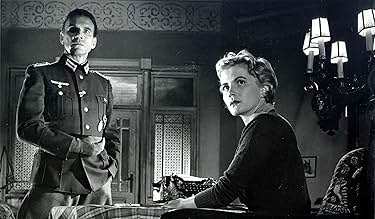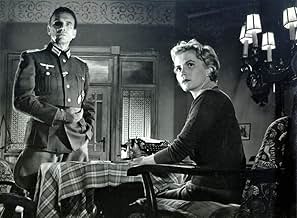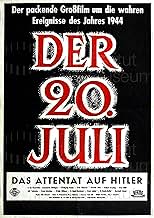Ajouter une intrigue dans votre langueA disillusioned Wehrmacht officer named Colonel Claus von Stauffenberg and his co-conspirators attempt to assassinate Adolf Hitler on 20 July 1944.A disillusioned Wehrmacht officer named Colonel Claus von Stauffenberg and his co-conspirators attempt to assassinate Adolf Hitler on 20 July 1944.A disillusioned Wehrmacht officer named Colonel Claus von Stauffenberg and his co-conspirators attempt to assassinate Adolf Hitler on 20 July 1944.
- Prix
- 3 victoires et 1 nomination
Histoire
Le saviez-vous
- AnecdotesFinal film of actress Charlotte Ander ,
- GaffesWounded in action previously, Stauffenberg lost his left eye. In the film, the actor playing Stauffenberg, wears an eye-patch covering the right eye.
- ConnexionsFeatured in Was geschah wirklich am 20. Juli 1944? (2004)
Commentaire en vedette
(Version reviewed is the 95-minute showing on ARD on July 24, 2001. There seems to be a scene excluded with Hildegard and Cpt. Lindner telling the story as a flashback. Film has no credits at all.)
Dr. Harnack, once a resistance member himself, shot a fabulous, never boring picture, eleven years after the attempted assassination of German "Führer" Adolf Hitler. Graf Schenk von Stauffenberg (Wolfgang Preiss in an appropriate rôle), a leading member of the secret regime resistance group around Goerdeler and Beck (played by veteran actors Paul Bildt and Werner Hinz), decides to kill Hitler soon after his installment as chief of staff of Eastern replacement troops. After a first try has failed - General von Tresckow says: "That guy (Hitler) has even chance on his side" - , Stauffenberg himself places a time bomb in Hitler's headquarters in Eastern Prussia. Then follows a minute description of the main events of the rest of the day, July 20, 1944.
Authors Weisenborn, Lüddecke and Harnack extended the depiction of events to a preacher and a civilian resistance group in Berlin. The frequent change of perspectives, though, was an unfortunate choice.
Another plot is about two fictitious characters, Hildegard Klee (Annemarie Düringer) and Captain Lindner (Robert Freytag), who is a dedicated Nazi officer. When both watch how an innocent Jewish doctor is brutally arrested, the officer states: "These are excesses only. But the front isn't part of it. The front is clean!" - "But you're fighting for it!" Hildegard answers. - It's supposed to make clear why German resistance consisted of (aristocratic) officers to a large extent. - Lindner is finally convinced when he reports about witnessing the killing of women and children when he is back at war again.
Although there have been controversies among historians about the (would-be) assassins' motives, and research has been done for over forty years since, the film is still a fine history lesson. There is an indication of the different aims in one scene when socialists and monarchists quarrel at a secret meeting until a philosophical Maximilian Schell settles the conflict. The narrator later declares that the July 20 action was "about the destruction of illegitimate tyranny and about the honor of the German name."
In consequence, when Stauffenberg ponders over what he is resolved to do, Harnack lets him view scenes of bomb attacks, tanks approaching and soldiers wounded before his mind's eye (all archive material), but there is only a very short take of what might be a KZ barbed wire fence: the fate of millions of Jews appears not to have been a motive.
Although very well done, "Der 20. Juli" is not a stand-out cinematographically. It was produced in competition with G. W. Pabst's "Es geschah am 20. Juli", which premiered a trifle earlier. Of the actors, Ernst Schröder is very efficient as the relentless hunter of resistant fighters, credible and far away from the caricatures in some American and British war movies. Likewise, Düringer, Freytag and Preiss do fine jobs.
Dr. Harnack, once a resistance member himself, shot a fabulous, never boring picture, eleven years after the attempted assassination of German "Führer" Adolf Hitler. Graf Schenk von Stauffenberg (Wolfgang Preiss in an appropriate rôle), a leading member of the secret regime resistance group around Goerdeler and Beck (played by veteran actors Paul Bildt and Werner Hinz), decides to kill Hitler soon after his installment as chief of staff of Eastern replacement troops. After a first try has failed - General von Tresckow says: "That guy (Hitler) has even chance on his side" - , Stauffenberg himself places a time bomb in Hitler's headquarters in Eastern Prussia. Then follows a minute description of the main events of the rest of the day, July 20, 1944.
Authors Weisenborn, Lüddecke and Harnack extended the depiction of events to a preacher and a civilian resistance group in Berlin. The frequent change of perspectives, though, was an unfortunate choice.
Another plot is about two fictitious characters, Hildegard Klee (Annemarie Düringer) and Captain Lindner (Robert Freytag), who is a dedicated Nazi officer. When both watch how an innocent Jewish doctor is brutally arrested, the officer states: "These are excesses only. But the front isn't part of it. The front is clean!" - "But you're fighting for it!" Hildegard answers. - It's supposed to make clear why German resistance consisted of (aristocratic) officers to a large extent. - Lindner is finally convinced when he reports about witnessing the killing of women and children when he is back at war again.
Although there have been controversies among historians about the (would-be) assassins' motives, and research has been done for over forty years since, the film is still a fine history lesson. There is an indication of the different aims in one scene when socialists and monarchists quarrel at a secret meeting until a philosophical Maximilian Schell settles the conflict. The narrator later declares that the July 20 action was "about the destruction of illegitimate tyranny and about the honor of the German name."
In consequence, when Stauffenberg ponders over what he is resolved to do, Harnack lets him view scenes of bomb attacks, tanks approaching and soldiers wounded before his mind's eye (all archive material), but there is only a very short take of what might be a KZ barbed wire fence: the fate of millions of Jews appears not to have been a motive.
Although very well done, "Der 20. Juli" is not a stand-out cinematographically. It was produced in competition with G. W. Pabst's "Es geschah am 20. Juli", which premiered a trifle earlier. Of the actors, Ernst Schröder is very efficient as the relentless hunter of resistant fighters, credible and far away from the caricatures in some American and British war movies. Likewise, Düringer, Freytag and Preiss do fine jobs.
- frank_olthoff
- 23 juill. 2001
- Lien permanent
Meilleurs choix
Connectez-vous pour évaluer et surveiller les recommandations personnalisées
Détails
- Date de sortie
- Pays d’origine
- Langues
- Aussi connu sous le nom de
- The Plot to Assassinate Hitler
- société de production
- Consultez plus de crédits d'entreprise sur IMDbPro
- Durée1 heure 37 minutes
- Couleur
- Mixage
- Rapport de forme
- 1.37 : 1
Contribuer à cette page
Suggérer une modification ou ajouter du contenu manquant

Lacune principale
By what name was Der 20. Juli (1955) officially released in India in English?
Répondre



















